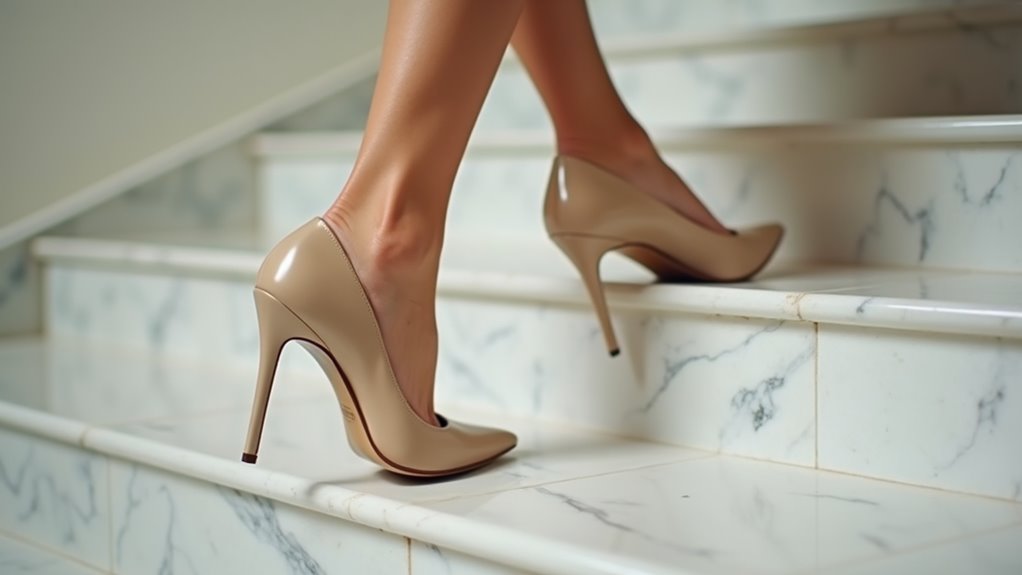There may be products. Products are independently selected by our editors. We may earn an affiliate commission from the links with no charge to you, example: as Amazon Affiliate.
We’ll guide you through proven strategies for pain-free heel wearing, starting with proper fit and gradual adaptation. Your shoes should fit perfectly from day one, with ample toe box space to prevent bunions and blisters. We recommend beginning with lower heel heights (under 3 inches) and implementing targeted cushioning solutions like gel insoles and memory foam padding. Focus on correct walking technique: heel-first stride, engaged core, and shoulder retraction for optimal weight distribution. Regular foot strengthening exercises and strategic rest periods between wear are essential. Our comprehensive approach to heel comfort extends far beyond these fundamentals.
Key Takeaways
- Choose shoes that fit perfectly from the start, with adequate toe box space and heel heights under 3 inches for optimal comfort.
- Break in new heels gradually at home, starting with 15-minute intervals while wearing thick socks to help stretch the material.
- Use gel insoles and cushioning pads to redistribute pressure away from the ball and heel of your feet.
- Walk heel-to-toe with smaller steps, maintain good posture, and engage your core for better balance and stability.
- Allow 24-hour breaks between wearing heels and practice foot stretches to maintain muscle flexibility and prevent discomfort.
Finding Your Perfect Fit
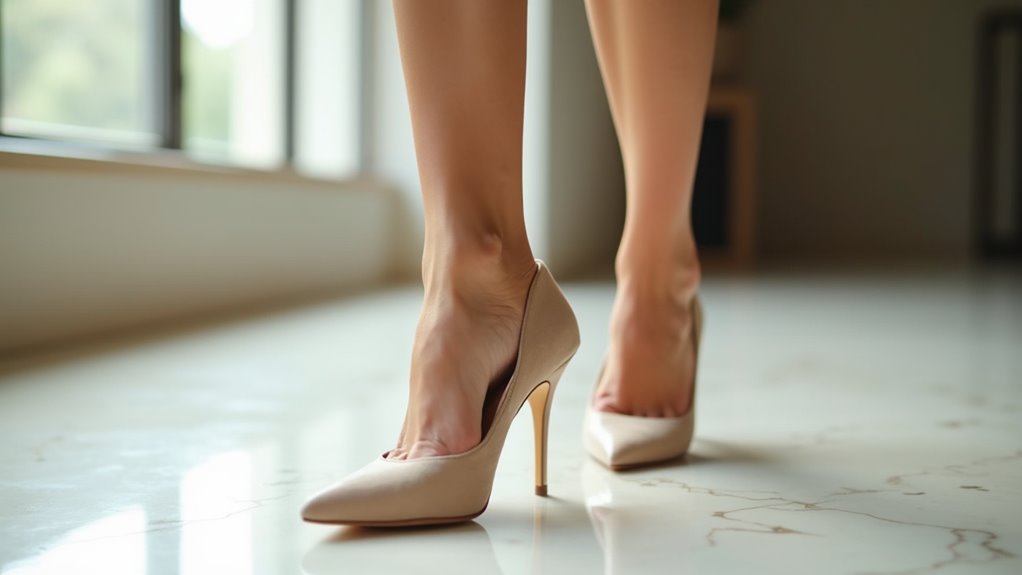
When it comes to wearing heels comfortably, finding your perfect fit serves as the foundation for pain-free walking. We’ll need to ensure your shoes accommodate both the width and natural arch of your feet, which requires precise measurements of your feet’s dimensions. Remember, our feet can change size over time, so regular measuring is essential for maintaining optimal shoe fit.
Let’s focus on the toe box space, which is particularly crucial in heels. We want to see ample room for your toes to spread naturally without compression, as this helps prevent the development of painful conditions like bunions and blisters. When we’re selecting heels, we’ll check that there’s enough space to wiggle your toes freely.
If you’re experiencing persistent discomfort, we’ll want to consider custom orthotic insoles. These can provide targeted support for your unique foot structure and improve overall alignment. While trying on heels, we’ll assess how your feet feel throughout the entire shoe, paying special attention to pressure points that could cause problems during extended wear. Your comfortable shoes should feel right from the moment you put them on – there’s no “breaking in” period when the fit is correct. For maximum comfort during long days at work, consider investing in cushioned formal shoes that combine style with padding.
Breaking In New Heels
Even with the perfect fit, new heels require a methodical breaking-in process to achieve optimal comfort and prevent strain on your feet’s anatomical structures. We recommend initiating the break-in period within the controlled environment of your home, where we can systematically acclimate our feet to the new footwear dynamics while minimizing potential podiatric complications. Focusing on comfort-focused heel designs can make the breaking-in process significantly easier.
Let’s follow these essential steps for breaking in a new pair of heels:
- Wear thick socks with your heels indoors, allowing the material to expand and conform to your foot’s unique architecture
- Practice walking on carpeted surfaces to protect both the shoe’s sole and your foot’s pressure points
- Gradually increase wearing duration, starting with 15-minute intervals to prevent excessive stress on metatarsal bones
- Utilize shoe stretchers during non-wear periods to maintain consistent pressure on tight areas
During this adjustment period, we must vigilantly monitor for signs of discomfort, including redness, pressure points, or early blister formation. By implementing preventive measures such as protective padding and anti-friction products, we can significantly reduce the likelihood of developing uncomfortable pressure zones or friction-related injuries.
Mastering The Walking Technique
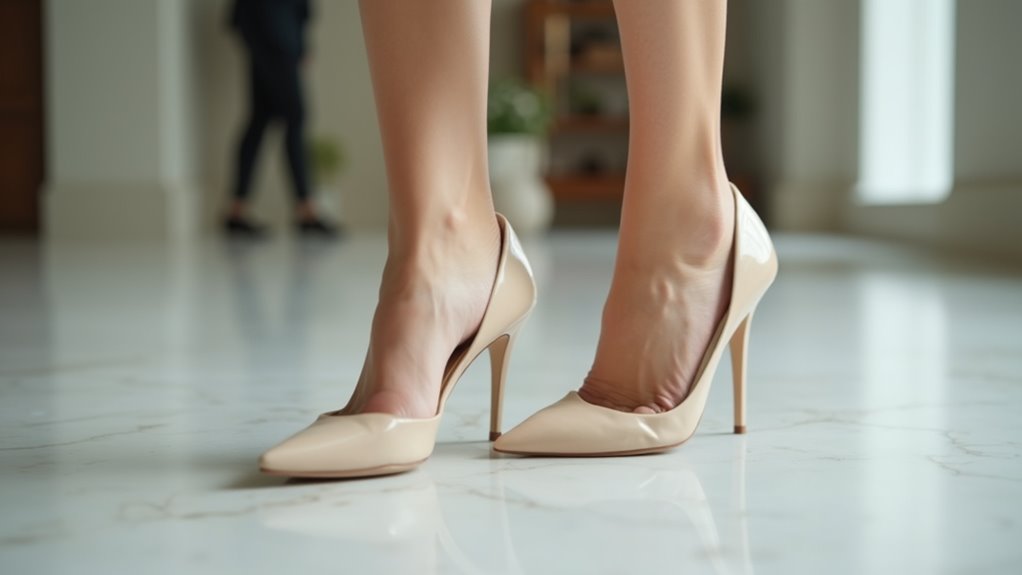
Mastering proper heel-walking technique establishes the foundation for long-term comfort and foot health while wearing elevated footwear. When walking in heels, we’ll begin each stride by landing on the posterior aspect of the foot (heel) before transitioning our weight forward to the anterior portion (toes), maintaining biomechanical efficiency and reducing metatarsal strain.
We’ll focus on adopting a slight posterior lean while walking, which helps distribute body weight more evenly across the foot’s structural components. This positioning is crucial for pain relief and preventing excessive pressure on the forefoot. By taking smaller, measured steps, we’re enabling better control over our center of gravity and reducing the risk of ankle instability.
Core engagement and proper shoulder positioning are essential components of our walking mechanics. We’ll maintain an erect spine while keeping our shoulders retracted, creating a stable foundation that minimizes the risk of musculoskeletal complications. Through consistent practice, we’ll develop muscle memory that enables confident, graceful movement in heels while protecting our feet from unnecessary stress and potential injury. Selecting heels with comfort technology features can provide additional support and cushioning while mastering these walking techniques.
Strategic Cushioning Solutions
Let’s examine how strategic gel insoles provide crucial support by redistributing pressure away from the ball of the foot and heel during heel wear. We can enhance our anatomical comfort by incorporating custom orthotic padding that conforms to our foot’s unique structure while improving overall alignment. Through targeted cushioning techniques, including adhesive heel grips and non-slip pads, we’re able to stabilize foot positioning and minimize friction points that typically cause discomfort. Quality heel inserts provide advanced comfort technology designed specifically for extended periods of wear.
Gel Insoles for Support
For immediate relief from heel-induced discomfort, gel insoles offer targeted cushioning that strategically distributes pressure across the foot’s anatomy. We’ve found that these specialized inserts mold precisely to your foot’s contours, creating a customized support system that minimizes friction points and reduces the likelihood of developing painful pressure spots.
When we examine the anatomical benefits of gel insoles, particularly in the ball of foot region, we notice significant improvements in weight distribution and overall comfort. These inserts work by absorbing shock and creating a stable platform that helps maintain proper foot alignment throughout the day.
- Redistributes pressure points across the entire plantar surface
- Provides targeted cushioning to the metatarsal area
- Reduces friction between foot and shoe interior
- Supports natural arch alignment during movement
We’ve observed that incorporating gel insoles into your footwear routine can enhance postural alignment and reduce strain on your entire kinetic chain, from ankles to lower back. This anatomically-focused approach to comfort doesn’t just address immediate discomfort; it helps create a more sustainable foundation for long-term heel wearing.
Targeting Pressure Points
Building upon the foundation of gel insoles, strategic pressure point targeting offers another layer of anatomical support for heel wearers. We’ve found that precise cushioning placement at key pressure points dramatically reduces pain in your feet during extended heel wear.
Let’s focus on specific anatomical zones that require attention. We recommend applying gel or padded inserts directly to the ball of the foot and heel areas, where maximum pressure occurs. By incorporating bunion protectors and silicone pads, we’re able to minimize friction at sensitive contact points, effectively preventing blister formation.
For advanced pressure point management, we utilize a specialized taping technique for the third and fourth toes, which alleviates nerve compression. We’ve discovered that thick maxi pads serve as an economical yet effective cushioning alternative, offering superior moisture control while maintaining a discrete profile within shoes.
To complete our pressure point strategy, we implement adhesive grips and non-slip pads. These not only enhance stability but also create an optimal weight distribution pattern across the foot’s pressure points, significantly reducing discomfort during prolonged heel wear.
Custom Padding Options
Strategic cushioning solutions represent the cornerstone of personalized heel comfort, with custom padding options offering targeted support for individual foot structures. We’ve found that orthotic insoles specifically designed for your foot’s unique anatomy can dramatically improve foot alignment and weight distribution, transforming an uncomfortable pair of heels into a more wearable option.
- Orthotic insoles that contour to your arch, providing personalized support and maintaining proper foot alignment throughout wear
- Gel and padded inserts strategically placed at the ball of foot and heel zones for maximum impact absorption
- Nude medical tape applications for nerve protection, particularly beneficial for toe sensitivity
- Maxi pad cushioning solutions that offer dual benefits of moisture absorption and pressure redistribution
When implementing custom padding strategies, we recommend regular assessment of pressure points and adjustment of cushioning materials. This anatomical approach ensures optimal biomechanics while walking in heels. By incorporating these tailored support systems, we can effectively address individual comfort needs while maintaining proper foot positioning, ultimately reducing the risk of strain and potential injuries associated with prolonged heel wear.
Choose The Right Height
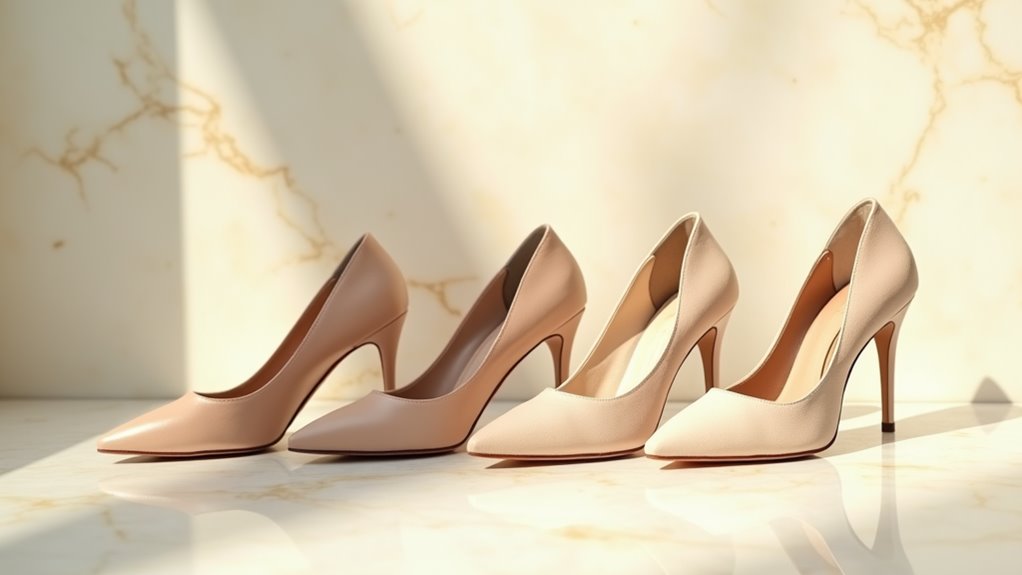
We’ll prioritize selecting the optimal heel height for our feet by beginning with lower styles like kitten heels or block heels, which allow our foot anatomy to adapt gradually to elevated positions. Our daily heel height shouldn’t exceed 3 inches, as this maintains proper weight distribution and minimizes strain on our metatarsals and toe joints. We’ll assess our individual comfort threshold by monitoring how our feet respond to different heights, paying attention to pressure points and biomechanical changes in our walking pattern. For unpredictable weather conditions, weather-resistant heels provide stability and protection while maintaining sophisticated style.
Start Low and Slow
The journey to comfortable heel-wearing begins with selecting an appropriate height that allows your feet to adapt gradually. When we’re developing our ability to wear high heels without discomfort, starting with modest heel heights of 3 inches or lower provides our feet with the necessary foundation to build strength and stability.
Let’s focus on these essential steps for pain-free heel wearing:
- Begin with kitten heels or block heels at 2-3 inches to establish proper foot positioning and balance
- Allow 2-3 weeks of consistent wear at each heel height before increasing
- Monitor foot discomfort and adjust wearing duration accordingly
- Choose contemporary lower-heeled styles that align with current fashion trends
Our feet require time to develop the muscular strength and flexibility needed for higher heels. By following current fashion’s shift toward more manageable heel heights, we can maintain both style and anatomical health. The progressive approach allows our foot structures to adapt while minimizing strain on the metatarsal bones and plantar fascia. This methodical elevation increase helps prevent common issues like ball-of-foot pain and arch strain, ensuring we can confidently wear heels for extended periods.
Perfect Your Daily Height
Once you’ve mastered wearing lower heels, identifying your optimal daily heel height becomes a key factor in maintaining foot health. We recommend starting with heels no higher than 3 inches, as this height provides the ideal balance between style and comfort while minimizing strain on your foot structure. Your individual foot shape plays a crucial role in determining the most suitable height for daily wear.
Mid-heels and block heels offer superior stability and support compared to higher alternatives, making them excellent choices for regular use. We’ve found that these styles distribute weight more evenly across the foot, reducing pressure points and potential long-term damage. When selecting your daily heel height, consider how different elevations affect your gait and comfort throughout the day.
For optimal comfort and foot health, we suggest maintaining a collection of heels at varying heights, focusing primarily on those under 3 inches. Pay special attention to the toe box width in relation to your foot shape, as proper spacing prevents compression and discomfort. By following current trends that favor lower, more anatomically friendly designs, we can protect our feet while maintaining style.
Know Your Comfort Limit
Understanding your personal comfort threshold stands out as a critical factor in selecting appropriate heel heights for long-term foot health. When wearing high heels, we must recognize that our comfort limit directly impacts how our feet respond to extended periods of wear. Scientific evidence shows that maintaining heel heights of 3 inches or below helps preserve natural weight distribution and reduces the risk of developing musculoskeletal issues.
- Monitor your calf muscles for signs of shortening or stiffness, as research indicates frequent high heel use can alter tendon structure
- Start with lower heights (1-2 inches) to build foot strength and stability before progressing
- Pay attention to how your weight shifts across your metatarsals when testing different heights
- Assess comfort during both standing and walking, as dynamic movement affects foot pressure points
We’ve observed that beginners achieve optimal results by starting with kitten heels or block heels, which provide stability while maintaining style. Current fashion trends support this anatomically-conscious approach, offering numerous options that align with proper foot biomechanics. By respecting our individual comfort limits, we protect our feet while still enjoying elevated style.
Rest And Recovery Methods
Proper rest and recovery methods play a critical role in maintaining foot health when wearing high heels regularly. We recommend implementing a minimum 24-hour rest period between wearing sessions, allowing your feet to recuperate from the altered pressure distribution and muscle tension.
During these recovery periods, we’ll want to focus on targeted stretching exercises for the calf and foot muscles. These stretches help maintain flexibility and counteract the muscular shortening that occurs from frequent heel wear. Toe curls and arch lifts are particularly effective exercises that strengthen the intrinsic foot muscles, building resilience against future discomfort.
We’ve found that incorporating therapeutic foot massages stimulates circulation and releases tension in overworked muscles. To enhance your recovery routine, we suggest using gel inserts or cushioned insoles when you return to wearing heels, as they provide essential support for pressure redistribution. Consider investing in comfort cushions for heels specifically designed to provide targeted pressure relief and support. This comprehensive approach to foot recovery combines active strengthening with passive support methods. By adhering to these anatomically-focused recovery techniques, we’re enabling our feet to better withstand the biomechanical challenges of high heel wear while minimizing potential discomfort and strain.
Strengthening Your Feet
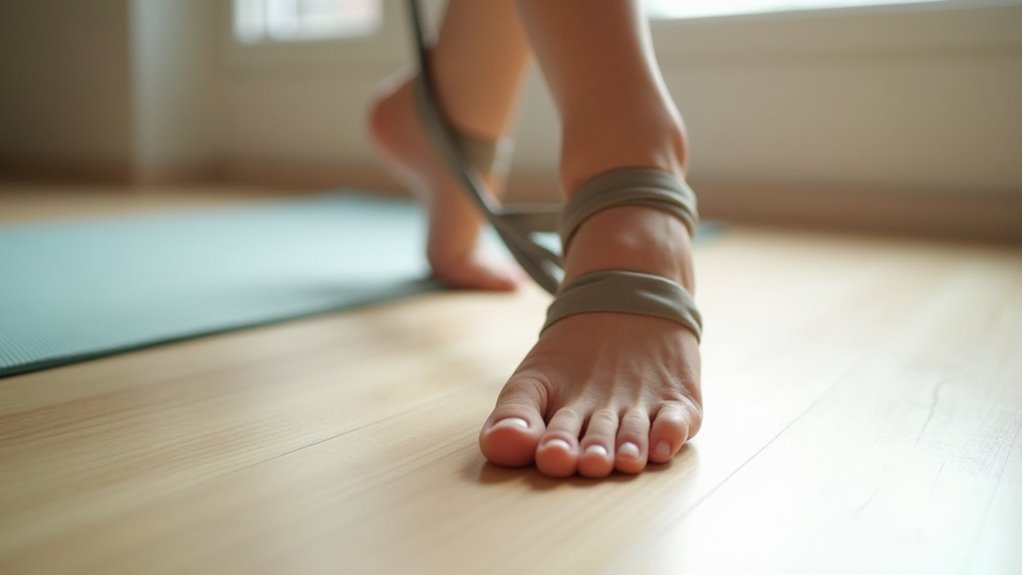
Strong feet form the foundation for comfortable heel wearing, and targeted strengthening exercises can significantly enhance your foot’s resilience. When we focus on strengthening your feet through consistent exercise, we’re building the essential muscle support needed for prolonged heel wear. Our feet and ankles require specific attention to develop the stability and endurance necessary for navigating various heel heights.
- Perform daily toe curls and calf raises to activate the intrinsic foot muscles and enhance ankle stability
- Practice single-leg balance exercises to improve proprioception and reduce ankle instability
- Implement plantar fascia and Achilles tendon stretches to maintain optimal foot flexibility
- Use foam rolling techniques to release tension in foot muscles and promote circulation
We recommend incorporating these exercises into your daily routine, gradually increasing duration and intensity. Regular foot strengthening not only improves your ability to wear heels comfortably but also enhances overall foot health. By combining targeted foot exercises with proper rest periods, we’re establishing a comprehensive approach to foot conditioning. Remember to maintain consistency with these exercises, as the adaptations in foot strength and flexibility develop over time through regular practice. Using podiatrist-approved products can provide additional support while performing these strengthening exercises.
Selecting Support Features
We need to prioritize proper cushioning in heels through strategic placement of gel or padded inserts, particularly in high-impact areas like the ball of the foot and heel. Our feet’s pressure points require targeted support, which we can achieve by incorporating leather insoles that naturally conform to our unique foot structure while maintaining flexibility. By combining these cushioning elements with precise insole placement, we’re creating a comprehensive support system that distributes weight evenly and minimizes strain on our feet’s pressure zones. Choosing sustainable shoe materials can provide both eco-conscious comfort and reliable support for your feet.
Cushioning for Maximum Comfort
The cornerstone of comfortable heel-wearing lies in selecting optimal cushioning features that protect your foot’s pressure points. We’ve found that proper cushioning significantly reduces strain on the ball of your foot while redistributing weight across the entire foot structure. When we examine the anatomical benefits of gel and padded insoles, it’s clear they provide essential support for the metatarsal region.
Here are the key cushioning elements we recommend for maximum comfort:
- Gel-based ball of foot cushions that specifically target metatarsal pressure points
- Memory foam insoles that conform to your unique foot architecture
- Anatomically-designed padding that redistributes weight from high-pressure areas
- Cushioned inserts with medical-grade materials that prevent bunion development
We’ll want to focus on shoes that incorporate built-in cushioning systems, particularly those featuring memory foam technology. When we assess proper cushioning placement, it’s crucial to ensure the padding extends throughout the toe box area. This anatomical approach to cushioning helps maintain proper foot alignment while preventing common conditions like metatarsalgia. By selecting heels with adjustable straps and adequate cushioning, we’re supporting natural foot mechanics and reducing strain on sensitive pressure points.
Strategic Insole Placement Matters
Building upon proper cushioning techniques, strategic insole placement represents a fundamental component of heel comfort optimization. We’ve found that the precise positioning of orthotic insoles can dramatically improve foot alignment and redistribute pressure points that typically cause discomfort when wearing heels.
When we’re distributing your weight properly through strategic insole placement, we’re able to address specific anatomical needs. For those with high arches or flat feet, custom-made insoles provide targeted support exactly where it’s needed most. We recommend positioning gel inserts specifically under the ball of the foot, where pressure tends to concentrate in high heels.
Let’s focus on maximizing foot health through proper insole integration. Over-the-counter cushioned options should be positioned to support your foot’s natural arch while maintaining stability throughout the heel-to-toe transition. We’ve observed that correct placement enhances balance by creating a more stable foundation within the shoe. By ensuring your insoles are strategically placed, we’re not just adding comfort – we’re creating an anatomically sound environment that supports prolonged heel wear while minimizing the risk of foot-related complications.
Avoiding Common Pressure Points
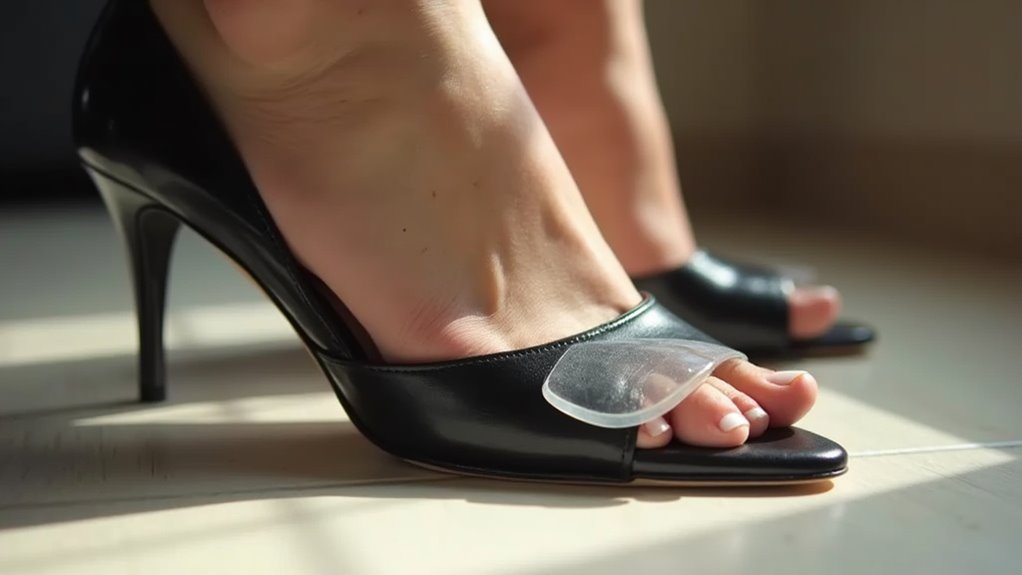
Managing pressure points effectively requires strategic attention to how footwear interacts with your foot’s anatomy. We’ve found that selecting shoes with a wider toe box and rounded toe shapes significantly reduces compression on the metatarsal heads and phalanges, where most pressure-related discomfort originates.
Let’s focus on four essential strategies to minimize pressure point pain:
- Implement targeted gel padding placement at primary contact zones between foot and shoe
- Apply medical tape across the third and fourth toes to protect nerve pathways
- Select footwear with anatomically appropriate width at pressure distribution points
- Monitor and adjust fit regularly to prevent friction-induced irritation
When we examine the biomechanics of heel-wearing, we notice that pressure concentrates primarily at the ball of the foot and toe joints. By incorporating cushioned inserts at these specific anatomical locations, we’re able to redistribute weight more evenly across the foot’s surface area. This systematic approach to managing pressure points allows us to maintain proper foot positioning while minimizing the risk of developing painful pressure-related complications that often occur with prolonged heel wear. For enhanced comfort during extended wear, consider using medical support pumps to improve circulation and reduce swelling in the feet and ankles.
Smart Shopping For Comfort
After understanding how to manage pressure points, we can apply this knowledge when selecting appropriate footwear. Let’s focus on key anatomical considerations when shopping for heels that won’t compromise foot health.
First, we’ll address proper shoe fit by measuring both foot length and width regularly, as these dimensions can change over time. When examining potential footwear, we should prioritize designs with rounded toe boxes that accommodate natural toe splay and prevent compression of the metatarsal region. This anatomical awareness helps prevent the development of bunions and other podiatric concerns.
The heel height selection is crucial for maintaining proper skeletal alignment. We’ll want to keep heels at or below 3 inches to minimize strain on the plantar fascia and achilles tendon. Chunky heels or wedges provide optimal stability by distributing body weight more evenly across the foot’s structure.
Finally, we must evaluate the cushioning features of potential footwear. Look for shoes with adequate padding in the footbed, particularly in the metatarsal area and heel cup. Gel inserts or specialized cushioning technology can enhance the shoe’s ability to absorb impact and maintain proper foot positioning. For the ultimate walking experience, consider investing in premium comfort heels designed specifically to minimize discomfort during extended wear.
Conclusion
As we’ve explored the anatomy of comfortable heel-wearing, we’re now equipped to elevate our stride without compromising foot health. Like a well-oiled machine, our feet’s complex network of bones, tendons, and muscles can adapt to height when properly supported. Through strategic cushioning, anatomically-correct fits, and strengthened plantar muscles, we’re transforming painful steps into confident strides. Our journey from toe compression to balanced weight distribution marks a new chapter in heel-wearing evolution.

